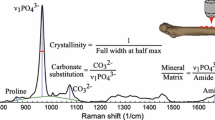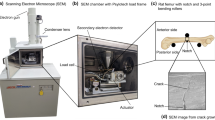Abstract
Osteocytes are the most abundant cell type in bone and remodel their local perilacunar matrix in response to a variety of stimuli and diseases. How the perilacunar composition and mechanical properties are affected by type 1 diabetes (T1D), and the contribution of these local changes to the decline in whole-bone functional properties that occurs with diabetes remains unclear. 12–14 week old C57/BL6 male mice were administered a series of low-dose streptozotocin injections and sacrificed at baseline (BL), 3 (D3) and 7 weeks (D7) following confirmation of diabetes, along with age-matched controls (C3, C7). Femora were then subjected to a thorough morphological (μCT), mechanical (four-point bending, nanoindentation), and compositional (HPLC for collagen cross-links, Raman spectroscopy) analysis at the whole-bone and local (perilacunar and intracortical) levels. At the whole-bone level, D7 mice exhibited 10.7% lower ultimate load and 26.4% lower post-yield work relative to C7. These mechanical changes coincided with 52.2% higher levels of pentosidine at D7 compared to C7. At the local level, the creep distance increased, while modulus and hardness decreased in the perilacunar region relative to the intracortical for D7 mice, suggesting a spatial uncoupling in skeletal adaptation. D7 mice also exhibited increased matrix maturity in the 1660/1690 cm−1 ratio at both regions relative to C7. The perilacunar matrix maturity was predictive of post-yield work (46%), but perilacunar measures were not predictive of ultimate load, which was better explained by cortical area (26%). These results show that diabetes causes local perilacunar composition perturbations that affect whole-bone level mechanical properties, implicating osteocyte maintenance of its local matrix in the progression of diabetic skeletal fragility.






Similar content being viewed by others
References
Vestergaard P (2007) Discrepancies in bone mineral density and fracture risk in patients with type 1 and type 2 diabetes–a meta-analysis. Osteoporos Int 18(4):427–444. https://doi.org/10.1007/s00198-006-0253-4
Merlotti D, Gennari L, Dotta F, Lauro D, Nuti R (2010) Mechanisms of impaired bone strength in type 1 and 2 diabetes. Nutr Metab Cardiovasc Dis 20(9):683–690. https://doi.org/10.1016/j.numecd.2010.07.008
Napoli N et al (2017) Mechanisms of diabetes mellitus-induced bone fragility. Nat Rev Endocrinol 13(4):208–219. https://doi.org/10.1038/nrendo.2016.153
Leanza G et al (2019) Risk factors for fragility fractures in type 1 diabetes. Bone 125:194–199. https://doi.org/10.1016/j.bone.2019.04.017
Saito M, Marumo K (2010) Collagen cross-links as a determinant of bone quality: a possible explanation for bone fragility in aging, osteoporosis, and diabetes mellitus. Osteoporos Int 21(2):195–214. https://doi.org/10.1007/s00198-009-1066-z
Acevedo C et al (2018) Contributions of material properties and structure to increased bone fragility for a given bone mass in the UCD-T2DM rat model of type 2 diabetes. J Bone Miner Res 33(6):1066–1075. https://doi.org/10.1002/jbmr.3393
Garnero P (2012) The contribution of collagen crosslinks to bone strength. Bonekey Rep 1:182. https://doi.org/10.1038/bonekey.2012.182
Siegmund T, Allen MR, Burr DB (2008) Failure of mineralized collagen fibrils: Modeling the role of collagen cross-linking. J Biomech 41(7):1427–1435. https://doi.org/10.1016/j.jbiomech.2008.02.017
Bonewald LF (2011) The amazing osteocyte. J Bone Miner Res 26(2):229–238. https://doi.org/10.1002/jbmr.320
Vahidi G, Rux C, Sherk VD, Heveran CM (2021) Lacunar-canalicular bone remodeling: Impacts on bone quality and tools for assessment. Bone 143:115663. https://doi.org/10.1016/j.bone.2020.115663
Buenzli PR, Sims NA (2015) Quantifying the osteocyte network in the human skeleton. Bone 75:144–150. https://doi.org/10.1016/j.bone.2015.02.016
Qing H et al (2012) Demonstration of osteocytic perilacunar/canalicular remodeling in mice during lactation. J Bone Miner Res 27(5):1018–1029. https://doi.org/10.1002/jbmr.1567
McNerny EMB, Gardinier JD, Kohn DH (2015) Exercise increases pyridinoline cross-linking and counters the mechanical effects of concurrent lathyrogenic treatment. Bone 81:327–337. https://doi.org/10.1016/j.bone.2015.07.030
Gardinier JD, Al-Omaishi S, Morris MD, Kohn DH (2016) PTH signaling mediates perilacunar remodeling during exercise. Matrix Biol 52–54:162–175. https://doi.org/10.1016/j.matbio.2016.02.010
Taylor EA et al (2020) Sequential treatment of estrogen deficient, osteopenic rats with alendronate, parathyroid hormone (1–34), or raloxifene alters cortical bone mineral and matrix composition. Calcif Tissue Int 106(3):303–314. https://doi.org/10.1007/s00223-019-00634-w
Lane NE et al (2006) Glucocorticoid-treated mice have localized changes in trabecular bone material properties and osteocyte lacunar size that are not observed in placebo-treated or estrogen-deficient mice. J Bone Miner Res 21(3):466–476. https://doi.org/10.1359/JBMR.051103
Dole NS et al (2017) Osteocyte-intrinsic TGF-β signaling regulates bone quality through perilacunar/canalicular remodeling. Cell Rep 21(9):2585–2596. https://doi.org/10.1016/j.celrep.2017.10.115
Tang SY, Herber R-P, Ho SP, Alliston T (2012) Matrix metalloproteinase–13 is required for osteocytic perilacunar remodeling and maintains bone fracture resistance. J Bone Miner Res 27(9):1936–1950. https://doi.org/10.1002/jbmr.1646
Damrath JG, Moe SM, Wallace JM (2022) Calcimimetics alter periosteal and perilacunar bone matrix composition and material properties in early chronic kidney disease. J Bone Miner Res 37(7):1297–1306. https://doi.org/10.1002/jbmr.4574
Rolvien T et al (2017) Vitamin D regulates osteocyte survival and perilacunar remodeling in human and murine bone. Bone 103:78–87. https://doi.org/10.1016/j.bone.2017.06.022
Rubin MR et al (2016) Advanced glycation endproducts and bone material properties in type 1 diabetic mice. PLoS ONE 11:e0154700. https://doi.org/10.1371/journal.pone.0154700
Kalaitzoglou E, Popescu I, Bunn RC, Fowlkes JL, Thrailkill KM (2016) Effects of type 1 diabetes on osteoblasts, osteocytes, and osteoclasts. Curr Osteoporos Rep 14(6):310–319. https://doi.org/10.1007/s11914-016-0329-9
Gortázar AR, Ardura JA (2020) Osteocytes and diabetes: altered function of diabetic osteocytes. Curr Osteoporos Rep 18(6):796–802. https://doi.org/10.1007/s11914-020-00641-z
Parajuli A et al (2015) Bone’s responses to mechanical loading are impaired in type 1 diabetes. Bone 81:152–160. https://doi.org/10.1016/j.bone.2015.07.012
García-Martín A et al (2012) Circulating levels of sclerostin are increased in patients with type 2 diabetes mellitus. J Clin Endocrinol Metab 97(1):234–241. https://doi.org/10.1210/jc.2011-2186
Notsu M et al (2017) Advanced glycation end product 3 (AGE3) increases apoptosis and the expression of sclerostin by stimulating TGF-β expression and secretion in osteocyte-like MLO-Y4-A2 cells. Calcif Tissue Int 100(4):402–411. https://doi.org/10.1007/s00223-017-0243-x
Piccoli A et al (2020) Sclerostin regulation, microarchitecture, and advanced glycation end-products in the bone of elderly women with type 2 diabetes. J Bone Miner Res 35(12):2415–2422. https://doi.org/10.1002/jbmr.4153
Mabilleau G, Perrot R, Flatt PR, Irwin N, Chappard D (2016) High fat-fed diabetic mice present with profound alterations of the osteocyte network. Bone 90:99–106. https://doi.org/10.1016/j.bone.2016.06.008
Maycas M et al (2017) PTHrP-derived peptides restore bone mass and strength in diabetic mice: additive effect of mechanical loading. J Bone Miner Res 32(3):486–497. https://doi.org/10.1002/jbmr.3007
Gustafson MB et al (1996) Calcium buffering is required to maintain bone stiffness in saline solution. J Biomech 29(9):1191–1194. https://doi.org/10.1016/0021-9290(96)00020-6
Gardinier JD, Mohamed F, Kohn DH (2015) PTH signaling during exercise contributes to bone adaptation. J Bone Miner Res 30(6):1053–1063. https://doi.org/10.1002/jbmr.2432
Schneider CA, Rasband WS, Eliceiri KW (2012) NIH Image to ImageJ: 25 years of image analysis. Nat Methods. https://doi.org/10.1038/nmeth.2089
Bouxsein ML, Boyd SK, Christiansen BA, Guldberg RE, Jepsen KJ, Müller R (2010) Guidelines for assessment of bone microstructure in rodents using micro–computed tomography. J Bone Miner Res 25(7):1468–1486. https://doi.org/10.1002/jbmr.141
Wallace JM, Golcuk K, Morris MD, Kohn DH (2009) Inbred strain-specific response to biglycan deficiency in the cortical bone of C57BL6/129 and C3H/He mice. J Bone Miner Res 24(6):1002–1012. https://doi.org/10.1359/jbmr.081259
Currey JD (1979) Mechanical properties of bone tissues with greatly differing functions. J Biomech 12(4):313–319. https://doi.org/10.1016/0021-9290(79)90073-3
Ritchie RO, Koester KJ, Ionova S, Yao W, Lane NE, Ager JW (2008) Measurement of the toughness of bone: a tutorial with special reference to small animal studies. Bone 43(5):798–812. https://doi.org/10.1016/j.bone.2008.04.027
McNerny EMB, Gong B, Morris MD, Kohn DH (2015) Bone fracture toughness and strength correlate with collagen cross-link maturity in a dose-controlled lathyrism mouse model. J Bone Miner Res 30(3):455–464. https://doi.org/10.1002/jbmr.2356
Bolger MW et al (2020) External bone size identifies different strength-decline trajectories for the male human femora. J Struct Biol 212:107650. https://doi.org/10.1016/j.jsb.2020.107650
Roberts HC, Knott L, Avery NC, Cox TM, Evans MJ, Hayman AR (2007) Altered collagen in tartrate-resistant acid phosphatase (TRAP)-deficient mice: a role for TRAP in bone collagen metabolism. Calcif Tissue Int 80(6):400–410. https://doi.org/10.1007/s00223-007-9032-2
Brown S, Worsfold M, Sharp C (2001) Microplate assay for the measurement of hydroxyproline in acid-hydrolyzed tissue samples. Biotechniques 30:38–40. https://doi.org/10.2144/01301bm06
Wu Z, Baker TA, Ovaert TC, Niebur GL (2011) The effect of holding time on nanoindentation measurements of creep in bone. J Biomech 44(6):1066–1072. https://doi.org/10.1016/j.jbiomech.2011.01.039
Oliver WC, Pharr GM (1992) An improved technique for determining hardness and elastic modulus using load and displacement sensing indentation experiments. J Mater Res 7(6):1564–1583. https://doi.org/10.1557/JMR.1992.1564
Raghavan M, Sahar ND, Kohn DH, Morris MD (2012) Age-specific profiles of tissue-level composition and mechanical properties in murine cortical bone. Bone 50(4):942–953. https://doi.org/10.1016/j.bone.2011.12.026
Mandair GS, Oest ME, Mann KA, Morris MD, Damron TA, Kohn DH (2020) Radiation-induced changes to bone composition extend beyond periosteal bone. Bone Rep 12:100262. https://doi.org/10.1016/j.bonr.2020.100262
Mansur SA et al (2015) Stable incretin mimetics counter rapid deterioration of bone quality in type 1 diabetes mellitus. J Cell Physiol 230(12):3009–3018. https://doi.org/10.1002/jcp.25033
Nyman JS et al (2011) Increasing duration of type 1 diabetes perturbs the strength–structure relationship and increases brittleness of bone. Bone 48(4):733–740. https://doi.org/10.1016/j.bone.2010.12.016
Farlay D, Armas LA, Gineyts E, Akhter MP, Recker RR, Boivin G (2016) Nonenzymatic glycation and degree of mineralization are higher in bone from fractured patients with type 1 diabetes mellitus. J Bone Miner Res 31(1):190–195. https://doi.org/10.1002/jbmr.2607
Sihota P et al (2021) Investigation of mechanical, material and compositional determinants of human trabecular bone quality in type 2 diabetes. J Clin Endocr Metab. https://doi.org/10.1210/clinem/dgab027
Lekkala S, Sacher SE, Taylor EA, Williams RM, Moseley KF, Donnelly E (2023) Increased advanced glycation endproducts, stiffness, and hardness in iliac crest bone from postmenopausal women with type 2 diabetes mellitus on insulin. J Bone Miner Res 38(2):261–277. https://doi.org/10.1002/jbmr.4757
Yee CS, Schurman CA, White CR, Alliston T (2019) Investigating osteocytic perilacunar/canalicular remodeling. Curr Osteoporos Rep 17(4):157–168. https://doi.org/10.1007/s11914-019-00514-0
Silva MJ et al (2009) Type 1 diabetes in young rats leads to progressive trabecular bone loss, cessation of cortical bone growth, and diminished whole bone strength and fatigue life. J Bone Mineral Res 24:1618–1627. https://doi.org/10.1359/jbmr.090316
Donnelly E, Boskey AL, Baker SP, van der Meulen MCH (2010) Effects of tissue age on bone tissue material composition and nanomechanical properties in the rat cortex. J Biomed Mater Res Part A 92A(3):1048–1056. https://doi.org/10.1002/jbm.a.32442
Paschalis EP, Verdelis K, Doty SB, Boskey AL, Mendelsohn R, Yamauchi M (2001) Spectroscopic characterization of collagen cross-links in bone. J Bone Miner Res 16(10):1821–1828. https://doi.org/10.1359/jbmr.2001.16.10.1821
Takahata M et al (2012) Mechanisms of bone fragility in a mouse model of glucocorticoid-treated rheumatoid arthritis: implications for insufficiency fracture risk. Arthritis Rheum 64(11):3649–3659. https://doi.org/10.1002/art.34639
Farlay D et al (2011) The ratio 1660/1690 cm(-1) measured by infrared microspectroscopy is not specific of enzymatic collagen cross-links in bone tissue. PLoS ONE 6:e28736. https://doi.org/10.1371/journal.pone.0028736
Mandair GS, Morris MD (2015) Contributions of Raman spectroscopy to the understanding of bone strength. Bonekey Rep 4:620. https://doi.org/10.1038/bonekey.2014.115
Unal M et al (2018) Assessing glycation-mediated changes in human cortical bone with Raman spectroscopy. J Biophoton 11:e201700352. https://doi.org/10.1002/jbio.201700352
Rux CJ, Vahidi G, Darabi A, Cox LM, Heveran CM (2022) Perilacunar bone tissue exhibits sub-micrometer modulus gradation which depends on the recency of osteocyte bone formation in both young adult and early-old-age female C57Bl/6 mice. Bone 157:116327. https://doi.org/10.1016/j.bone.2022.116327
Acknowledgements
We would like to thank Gurjit Mandair for training and assistance with Raman spectroscopy, and Ken Kozloff for use of the nanoindentation system. This work was supported by was supported by T32 DE007057, and P30AR069620. The content of this work is solely the responsibility of the authors and does not necessarily represent the official views of the National Institutes of Health.
Author information
Authors and Affiliations
Corresponding author
Ethics declarations
Conflict of interest
The authors (MB, TT, DK) have no financial or non-financial interests to disclose that are related to this publication.
Human and Animal Rights
All animal procedures and protocols were conducted with approval from the University of Michigan Institutional Animal Care and Use Committee (IACUC).
Informed Consent
This article does not contain any studies with human subjects performed by any of the authors. For this type of study, formal consent is not required.
Additional information
Publisher's Note
Springer Nature remains neutral with regard to jurisdictional claims in published maps and institutional affiliations.
Supplementary Information
Below is the link to the electronic supplementary material.
Rights and permissions
Springer Nature or its licensor (e.g. a society or other partner) holds exclusive rights to this article under a publishing agreement with the author(s) or other rightsholder(s); author self-archiving of the accepted manuscript version of this article is solely governed by the terms of such publishing agreement and applicable law.
About this article
Cite this article
Bolger, M.W., Tekkey, T. & Kohn, D.H. The Contribution of Perilacunar Composition and Mechanical Properties to Whole-Bone Mechanical Outcomes in Streptozotocin-Induced Diabetes. Calcif Tissue Int 113, 229–245 (2023). https://doi.org/10.1007/s00223-023-01098-9
Received:
Accepted:
Published:
Issue Date:
DOI: https://doi.org/10.1007/s00223-023-01098-9




